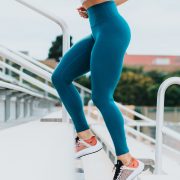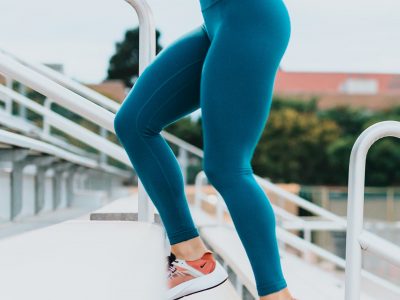Discover 20 standing ab exercises designed for women of all ages to help achieve a flat stomach. These effective standing ab workouts target your core, offering a convenient and powerful way to tone your abs without getting on the floor. Perfect for all fitness levels!
As a Certified Personal Trainer, I’ve recorded hundreds of ab workouts in the last few decades, and no doubt, the abs are the most requested body part to train.
I love a good plank series and core work on the mat, but my Pilates training taught me that you can work your abs both lying down and standing up, which is why I love these standing ab exercises.
Yes, standing up exercises for a flat stomach can be as effective if not more effective than core work on the mat. And I’m not surprised, because my fans have been asking me for the best standing abs workouts and off-the-floor exercises for years.
Standing workouts are popular for anyone dealing with back and knee pain, because it’s easier than getting up and down off the floor. These exercises also mimic normal everyday activities, meaning they make a great functional strength training workout!
The good news is you can do these standing core exercises right at home with minimal equipment.
Some of them are bodyweight exercises, and a few use a dumbbell, which you could substitute for a soup can, water jug, or even just use a throw pillow.
As a Certified Personal Trainer and Pilates instructor, here are my 20 recommended best standing ab exercises to add to your next workout.
1. Cross-Body Bicycle Crunches
Performing cross-body bicycle crunches will engage your entire core, emphasizing oblique muscles for improved rotational strength.
How to Perform Cross-Body Bicycle Crunches:
Stand with feet hip-width apart, knees slightly bent, hands behind head.
Keep low abs pulled in tight and lift left knee up as right shoulder rotates towards knee.
Lower back to start. Repeat on the opposite side.
2. Cross-Body Leg Lifts
This standing ab exercise will strengthen your lower abs and hip flexors, enhancing stability and balance.
How to Perform Cross-Body Leg Lifts:
Stand with feet hip-width apart, knees slightly bent, hands behind head.
Keep low abs pulled in tight and lift left leg straight up as right-hand reaches towards toes. Keep your back straight and your head up.
Lower back to start. Repeat on the opposite side.
3. Cross-Body Wood Chop
This cross-body wood chop move boosts core power and coordination by combining rotational movements with resistance.
How to Perform Cross-Body Wood Chop:
Stand with feet hip-width apart, holding a dumbbell end to end. Start in a squat position with your chest lifted, your abs tight, and the dumbbell to your right hip.
Stand up and swing the dumbbell up overhead over the left shoulder while contracting your abs.
Return to starting squat position. Repeat on the other side.
This standing exercise increases core engagement and cardiovascular endurance, targeting the lower abs.
How to Perform High Knee Lifts with a Dumbbell:
Begin standing. Extending one arm up, holding a dumbbell and the other arm out for counterbalance.
Alternate lifting your knees up to hip height, engaging your core to maintain balance.
Do desired reps total and then switch the dumbbell to the other hand and repeat.
This standing oblique exercise focuses on the obliques, enhancing side core strength and definition.
How to Perform Standing Oblique Crunches:
Stand with your feet shoulder-width apart. Lift right arm up overhead.
Bring the right knee up to the side to meet your right elbow, engaging through your obliques.
Return to standing. Repeat on the other side.
I love the dumbbell halo exercise for enhancing upper body and core stability, improving shoulder mobility and coordination.
How to Perform Dumbbell Halos:
Stand with your feet hip-width apart. Hold one dumbbell end to end at the right hip. Slightly bend your knees.
Bring the dumbbell up to your opposite shoulder and halo around the back of your head, ending with the dumbbell down at your left hip.
Keep alternating for the desired amount of repetitions.
Performing full body circles activates your entire core while enhancing flexibility and balance.
How to Perform Fully Body Circles:
Stand with your legs hip-width apart. Raise both arms up and clasp your hands overhead. Slightly soften your knees and contract your abs.
Bend forward at the hips and slowly draw a full circle with your body.
After several circles, one way, change directions.
This standing oblique exercise specifically targets your oblique muscles, improving side torso strength and toning.
How to Perform Oblique Burners:
Stand with wide feet, heels in, and toes turned out. Sink into a plie with knees bent and hands lightly touching the back of your head.
Bend to the right, reaching your right hand to the middle of your right calf.
Return to the center. Repeat on the other side.
This standing ab exercise combines leg and core work, enhancing stability and lower abdominal strength.
How to Perform Lunge Crunches:
Begin in a lunge position with your front knee bent at a 90-degree angle and the other leg extended behind you. Extend both arms out in front of you, holding a dumbbell end to end.
Engaging your core, drive the back knee up and in toward your chest while bending your elbows and pulling your arms into your abs.
Extend your leg back to the starting position and repeat. Keep crunching on the right side. Complete 15 reps, then switch sides and repeat.
Performing the reverse lunge twist engages your entire core, particularly the obliques, for improved rotational power.
How to Perform the Reverse Lunge Twist:
Start with your feet hip-width apart, with your arms holding a dumbbell end to end out in front of you.
Step back into a reverse lunge with your right leg, keeping your arms slightly bent, and twist your torso to the left over your left thigh. Make sure your front knee is over the toes and in a 90-degree angle.
Return to the start. Repeat on the other side.
This ab exercise strengthens your core and lower body while improving balance and coordination.
How to Perform Cross Behind Lunge with a Knee Lift:
Begin standing with your feet hip distance apart and your hands lightly touching the back of your head.
Cross your right foot behind your left leg keeping your hips facing forward as you bend both knees and lower yourself toward the floor in a lunge. Keep your back straight and chest lifted.
Drive your right knee up to meet your right elbow in a side crunch. Repeat for desired repetitions and repeat on the other side.
12. Cross Body Knee Thrusters
Performing cross body knee thrusters engages your entire core, emphasizing the obliques and lower abs for a toned midsection.
How to Perform Cross Body Knee Thrusters:
Stand with your feet hip-width apart and extend your arms up and over your right shoulder.
Drive your left knee up and across your body, and bring your arms down to meet your knee.
Return to start. Repeat on the other side.
This standing ab exercise targets your obliques and improves shoulder and core stability, enhancing flexibility.
How to Perform Dumbbell Windmills:
Stand with your feet a little wider than hip-width apart and your left foot slightly out. Hold a dumbbell with your right arm reaching overhead.
Keeping your right leg straight and your right arm overhead, push your butt back into your right leg and bend at the hip. Lean forward, reaching your left hand down towards the floor.
Only go as far down as you can without dropping the dumbbell forward. You will load your glutes, and hamstrings and feel it in your core as you lower down.
Stand back up, keeping the arm up towards the ceiling. Repeat on the other side.
Performing crossover toe touches engages your entire core, emphasizing flexibility and coordination.
How to Perform Crossover Toe Touches:
Stand with your feet wide and extend your arms into a T position.
Engage your core, rotate your torso to the left, and reach your right hand to your left foot. Bend your knees slightly if your hamstrings are tight.
Return back to standing and alternate to the other side.
This standing oblique exercise will strengthen your obliques and improve rotational flexibility and balance.
How to Perform a Side Twist Standing:
Stand with feet hip-width apart, slight bend at the knee, pelvis slightly tucked under, and abs pulled in toward the spine.
Hold your arms in a circle directly out in front of your chest, as if you are holding an imaginary beach ball. Take a deep breath in, and as you exhale, twist your imaginary ball to the left 3 times, moving far, farther, and farthest.
Do not move your hips. The rotation should come right at your ribcage.
Return to center, inhale, then twist the “ball” to the right far, farther, farthest, returning to the center to inhale. Repeat twisting three times in each direction.
The weighted oblique side bend exercise focuses on your oblique muscles, enhancing side strength and definition.
How to Perform Weighted Oblique Side Bends:
Stand with your feet hip-width apart and a dumbbell in each hand.
Slowly bend sideways to your right side as far as you comfortably can without leaning forward. Imagine you are against a sheet of glass.
Slowly return to the standing position and repeat on the other side.
I love using fast corner punches to increases core engagement and cardiovascular endurance while targeting my obliques.
How to Perform Fast Corner Punches:
Begin in a standing position with feet hip-width apart and knees slightly bent.
Pull your arms close to your side, bending the elbows and making two tight fists facing toward you.
Punch your left arm across your body to the right corner and then do the same to the left. Keep your hips steady and rotate from the waist area, contracting your abs.
Repeat for the desired amount of repetitions.
You might think of fast uppercuts as a boxing exercise, but this standing ab movement actually enhances core strength and coordination, focusing on your upper abs and obliques.
How to Perform Fast Uppercuts:
Begin in a standing position with feet hip-width apart and knees slightly bent.
Pull your arms close to your side, bending the elbows and making two tight fists facing toward you.
Punch each fist in an upward motion stopping right about chin level, alternating right and left. Keep your hips steady and rotate from the waist area, contracting your abs.
Repeat for the desired amount ofuppercut repetitions.
The chair pose with a twist exercise engages your entire core, improving balance, flexibility, and spinal strength.
How to Perform Chair Pose with a Twist:
Stand with your feet close together. Engaging your core and inner thighs, bend your knees and send your hips back into a chair pose.
Lift your chest and chin up, hands in a prayer position.
Rotate your upper body to the right, aiming to get your left elbow to your right knee. Think about rotating from the waist, and don’t rotate your hips.
Return back to the start and rotate to the other side.
Last, but not least! The single-leg weighted deadlift is a great option to strengthen your core, glutes, and hamstrings, while enhancing balance and stability.
How to Perform a Single-leg Weighted Deadlift:
Standing with feet together and holding a dumbbell in the left hand, lift your left foot up off the ground to establish your core balance.
Keeping your chest lifted and your back long, contract your abs and hip hinge over, extending your left leg behind you as you tip over towards the ground. Bring the dumbbell down only as far as you can hinge without rounding your back.
Bend your supporting knee slightly. You will feel this in the glutes and hamstrings.
Squeeze your glutes and engage your abs as you stand back up to start. Repeat on the other side.
Follow my instructions to incorporate these standing ab exercises into your weekly fitness routine.
Add to Existing Workouts: Add two or three standing ab exercises to any workout you do. Tack them on the end of your strength training workout or after your favorite cardio workout. Do approximately two sets of 10-12 repetitions of each exercise that you choose.
Make a Daily Habit: Perform at least one or two of these exercises for 15 reps every single day any time of day.
Create an Interval Workout: Make your own interval workout with 5-7 of these exercises. Do each exercise for 30 seconds and rest for 15 seconds in between. Don’t stop until you’ve gone through them all. Repeat the sequence of work to rest for another round if you are feeling energized.
Here are some of the amazing benefits of doing standing ab exercises versus traditional crunches and other moves on the floor. Trust me, they are just as, if not more, effective!
For many, standing core workouts help to establish overall consistency, which is the key to strengthening your abs. For many people, the idea of getting down on the floor and doing crunches seems just plain hard. Mental motivation is part of getting into better shape, and standing up is sometimes a little more doable for people and results in better consistency.
For those with bad knees, blood pressure issues, and other ailments, getting up and down off the floor can be difficult. Standing core exercises keeps you upright without worrying about being stuck down on the floor.
It’s a sneaky way to work on your balance. Standing ab workouts can also work to improve your balance which is an important component of graceful aging and staying active in older years.
Standing core exercises will help you move in all three planes of motion, which is important for an overall healthy and well-moving body. The three planes of motion include the sagittal, frontal, and transverse planes. These planes involve moving front and back, side-to-side, or rotationally, respectively.
I’m a fan of standing ab exercises for the challenge and the change of pace. All of these functional movements involve multiple muscle groups and focus on improving your strength and coordination while connecting your core to your whole body.
Explore more of my ab workouts to continue building a stronger core:
If you have any serious balance issues or any current ankle, hip, knee or back injuries, consult your doctor before engaging in these exercises.
Just like the Mayo Clinic says, “Your core is the central part of your body. Core strength leads to better balance and steadiness, also called stability.” Core stability is key to aging well. You need to be able to balance just to perform your ADL’s also known as activities of daily life.
No, you can perform all 20 of the exercises above with just your body weight. The dumbbell adds an extra bit of resistance to intensify the move, but bodyweight standing abs are very effective and can be done anywhere.











Comments